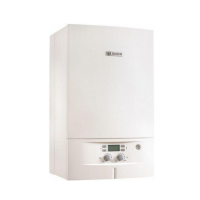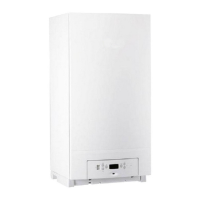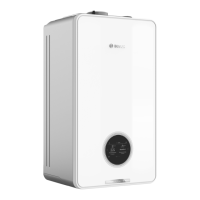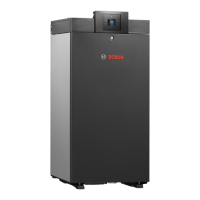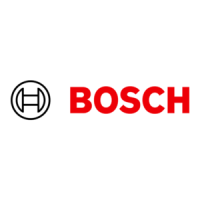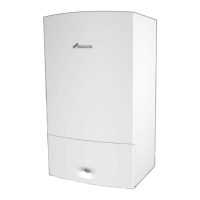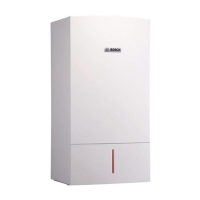16 | Regulations
Product Name6 720 ... ... (YYYY/MM)
3 Regulations
The boiler is designed to operated in conformity with the following
requirements:
• EN 677, EN 483, EN 15502
• EN 437
• Gas appliance directive 2009/142/EG
• Efficiency directive 92/42/EWG
• EMV directive 2004/108/EG
• Low voltage directive 2006/95/EG
3.1 Country specific regulations
For installation and operation, please refer to country specific standards
and regulations. Critical are:
• Local standards and regulations for siting the appliance
• Local standards and regulations for combustion air supply,
ventilation and connection to a flue gas system
• Regulations for connection to an electrical mains supply
• Regulations of the gas supplier for connecting a gas appliance onto
the local distribution network
• Standards and regulations for safety equipment on wet heating
systems
3.2 Approvals and notifications
• The installation of a gas boiler must be declared to, and approved by
the gas supplier.
• Please note, local regulations may require third party approval when
connecting to a flue gas system or drain condensate into the local
sewage system
• Where required, inform local representative (i.e. chimney sweeper)
before installing the boiler
3.3 Quality of the heating water
Use water to drinking water quality when filling and toping up the heating
system.
Unsuitable or contaminated water can lead to problems or damage of the
heat exchanger and water supply caused by i.e. sludge, corrosion and
scale build up.
Apply the following steps:
▶ Thoroughly flush the system before filling
▶ Water from wells and springs are not suitable as fill water
▶ Consider the total volume of scale introduced into the heating system
over its lifetime, by fill and top up water, and protect it against
damage with that in mind
▶ For systems with a volume 50litres/kW (i.e. when using buffer
vessels) the water must be treated. An approved solution is the full
removal of salts from the fill and top up water, achieving a
conductivity of 10
μsiemens/cm (= 10μS/cm).
Instead of a the water treatment solution you could install a means of
system separation (i.e. plate heat exchanger) directly after the
boiler.
▶ Please contact the manufacturer of the appliance for additional
inhibitors and anti freezes. Always refer to the manufacturer's advice
for filling and continuous maintenance when using these solutions.
3.4 Connection to combustion air and flue gas systems
• Always refer to the latest version of the applicable local standards
and regulations
• Further information about combustion air supply and connection to
flue gas systems can be found in chapter 5 in this manual.
• Also refer to the documentation supplied with the flue gas system.
3.5 Room air dependent operation
The boiler primarily operates as a “room air sealed” unit, however the
boiler can be operated as a “room air dependant” unit, if required.
Provide sufficient boiler room ventilation when operating the appliance
room air dependent
▶ Do not obstruct or block any ventilation openings
▶ Ventilation openings must always be kept clear
3.6 Flue gas systems type B
xx
Type B flue gas systems take combustion air from the boiler room. Flue
gas exits the appliance via the flue gas system. Special regulations apply
for installations of this type - comply with these requirements. Sufficient
combustion air must be available.
3.7 Flue gas systems type C
xx
Type C flue gas systems take combustion air from outside the building.
Flue gas exits the appliance via the flue gas system to the outside. To
ensure this, the combustion chamber door is air tight. Therefore always
ensure the combustion chamber door is closed when operating the
appliance room air sealed.
• Refer to the installation instructions of the flue gas system when
installing the appliance
3.8 Combustion air quality
To avoid corrosion, combustion air must be free from aggressive
substances (hydrogen halide, chlorines and fluorine).
3.9 Disposal
• Dispose any part of the heating system via an authorised facility
3.10 Inspection, service and maintenance
The heating system should be service regularly for the following reasons:
• To achieve and maintain a high efficiency and low fuel consumption
• To ensure operational safety
• To keep combustion clean and emissions low
Water quality is an important factor to increase the
efficiency, safety, reliability and availability of your
heating system.
DANGER: Risk to life from flue gas poisoning.
Insufficient combustion air supply can lead to flue gas
escaping.
▶ Ensure combustion air supply
▶ Supply and extract vents in doors, windows and
walls must not be closed off or reduced in size.
▶ Ensure a sufficient combustion air supply, also with
equipment installed afterwards: i.e. kitchen extract
fans and air conditioning units extracting air to the
outside
▶ Do not operate the appliance if combustion air
supply is insufficient.
NOTICE: Damage to boiler from contaminated
combustion air and contaminated air in the vicinity of
the appliance!
▶ Never operate the boiler in an dusty and chemically
aggressive environment i.e. spray painting, hair
dressing and farming facilities
▶ Never operate the boiler in places where using or
storing trichlorethane, hydrogen halide and other
aggressive chemical substances. These substances
can be contained in spray cans, various glues,
primers, paints and cleaning substances. In this case
always install the appliance room air sealed in a
hermetically sealed plant room with ventilation
directly to the outside.
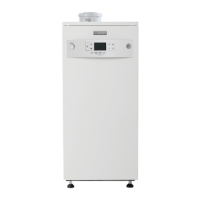
